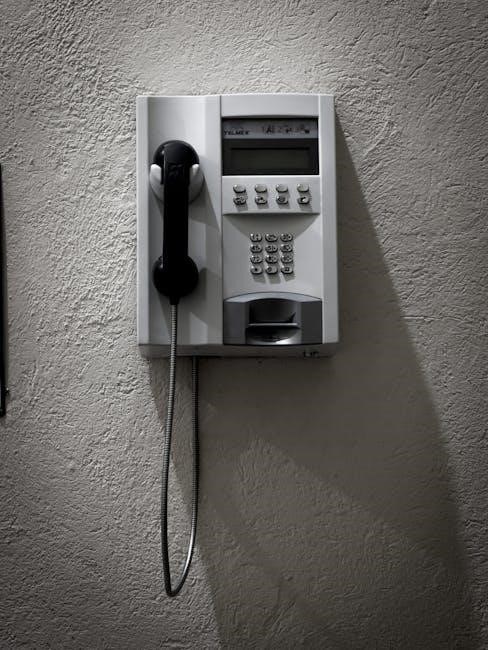Welcome to the ONN Rugged Speaker Manual! This guide helps you master your speaker’s features‚ including portable design‚ durability‚ and Bluetooth connectivity. Use this manual for setup‚ troubleshooting‚ and optimal performance.
1.1 Purpose of the Manual
This manual provides a comprehensive guide to understanding and using your ONN Rugged Speaker. It details features‚ setup‚ troubleshooting‚ and maintenance‚ ensuring optimal performance. Use this manual to explore functionality‚ resolve issues‚ and maximize your speaker’s potential for enhanced audio experiences.
1.2 Key Features of the ONN Rugged Speaker
The ONN Rugged Speaker offers a durable‚ water-resistant design with IPX7 certification‚ ensuring protection against water and dust. It features Bluetooth connectivity‚ a built-in carabiner for portability‚ and up to 20 hours of playtime. With powerful bass and clear sound‚ it includes intuitive controls for volume‚ track navigation‚ and pairing. Its rugged design makes it ideal for outdoor adventures‚ delivering reliable performance in various environments.

Unboxing and Initial Setup
Unbox your ONN Rugged Speaker‚ ensuring all accessories like the charging cable and manual are included. Charge the speaker fully before first use for optimal performance.
2.1 What’s in the Box
Your ONN Rugged Speaker box includes the speaker unit‚ a micro-USB charging cable‚ a quick start guide‚ and a warranty information booklet. Ensure all items are present before initial setup. The speaker features a built-in carabiner for portability‚ while the guide provides step-by-step instructions for pairing and troubleshooting. No additional accessories are typically included.
2.2 Charging the Speaker
To charge your ONN Rugged Speaker‚ use the included micro-USB cable. Connect the speaker to a power source via the USB port. Charging typically takes 3-4 hours. The LED indicator will glow red during charging and turn blue once fully charged. Avoid overcharging to maintain battery health. Refer to the manual for detailed charging guidelines and troubleshooting tips.
2.3 Initial Pairing Instructions
Start by turning on your ONN Rugged Speaker. Press and hold the Bluetooth button until the LED flashes blue. Enable Bluetooth on your device and select “ONN Rugged Speaker” from the list. Once connected‚ the LED will stop flashing. If pairing fails‚ restart both devices and retry. Ensure the speaker is fully charged before pairing for optimal performance.

Understanding the Speaker Controls
Explore the intuitive controls designed for seamless music management. The Power button‚ Volume controls‚ and Bluetooth button provide easy access to essential functions‚ enhancing your user experience.
3.1 Power Button Functionality
The Power button is essential for turning your speaker on/off. Press and hold it for 2 seconds to activate or deactivate. It also triggers Bluetooth pairing mode‚ indicated by a prompt or LED light. This button ensures smooth operation and quick starts for your listening sessions.
3.2 Volume Control and Track Navigation
Adjust volume using the dedicated buttons: press ‘+’ to increase and ‘-‘ to decrease. Short presses change volume‚ while holding skips tracks forward or backward. LED lights indicate volume levels‚ and voice prompts confirm actions. This feature ensures seamless control over your music playback experience with the ONN Rugged Speaker.
3.3 Bluetooth Pairing Button
The Bluetooth pairing button allows easy connection to devices. Press and hold it to enter pairing mode‚ indicated by flashing LED lights. Once paired‚ a voice prompt confirms the connection. The speaker remembers previously connected devices for quick reconnection. For multiple device pairing‚ activate Bluetooth on the second device and select the speaker’s name. Resetting may be needed for troubleshooting.
Bluetooth Connectivity
Experience seamless connectivity with the ONN Rugged Speaker’s Bluetooth functionality. Easily pair with devices‚ connect to multiple sources‚ and enjoy stable wireless audio with LED indicators for status feedback.
4.1 Pairing the Speaker with a Device
To pair the ONN Rugged Speaker‚ turn it on and press the Bluetooth button until the LED flashes. Activate Bluetooth on your device‚ select “ONN Rugged Speaker” from the list‚ and wait for confirmation. Once connected‚ the LED will stabilize‚ indicating successful pairing. The speaker will automatically reconnect to previously paired devices for seamless use.
4.2 Connecting to Multiple Devices
The ONN Rugged Speaker can connect to multiple devices simultaneously. To do this‚ pair each device one at a time‚ ensuring the speaker is in pairing mode each time. The speaker will store up to five devices and automatically reconnect to the last connected one. For multiple device setups‚ ensure your devices are in range and in pairing mode.
4.3 Troubleshooting Bluetooth Issues
If your ONN Rugged Speaker isn’t connecting via Bluetooth‚ ensure it’s in pairing mode and within range. Restart both the speaker and your device. Check for interference from other devices. If issues persist‚ reset the speaker by pressing and holding the power button for 10 seconds. This clears cached settings and restores default functionality. Ensure no other devices are connected to the speaker during pairing.

Battery Life and Charging
Your ONN Rugged Speaker offers up to 20 hours of playtime on a full charge. Use the included USB-C cable to charge; a full charge takes 3-4 hours. The LED indicator turns off when fully charged‚ ensuring optimal battery performance and longevity. Avoid overcharging to maintain battery health. Charge the speaker when the battery level is low to preserve its lifespan.
5.1 Expected Battery Life
Your ONN Rugged Speaker offers up to 20 hours of continuous playtime on a single charge‚ making it ideal for extended outdoor use. The built-in rechargeable battery ensures reliable performance‚ with a full charge typically taking 3-4 hours. The LED indicator provides clear charging status updates‚ while the speaker’s energy-efficient design helps maximize playback time. For optimal performance‚ charge the speaker when the battery level is low to maintain its longevity and avoid overcharging. This ensures consistent power delivery and extends the overall battery lifespan‚ allowing you to enjoy uninterrupted music sessions wherever you go.
5.2 Charging Indicators and Guidelines
The ONN Rugged Speaker features an LED charging indicator that displays red while charging and turns green when fully charged. Charge the speaker using the provided USB-C cable‚ typically requiring 3-4 hours for a full charge. Avoid overcharging to maintain battery health. Ensure the charging port is clean and dry to prevent connectivity issues. Always use the included charger for optimal performance and safety.

Rugged Design and Durability
The ONN Rugged Speaker boasts an IPX7 waterproof rating and a durable design‚ making it perfect for outdoor use. It includes a built-in carabiner for easy portability‚ ensuring versatility in any setting.
6.1 IPX7 Waterproof Rating
The ONN Rugged Speaker features an IPX7 waterproof rating‚ protecting it against immersion in water up to 1 meter for 30 minutes. This makes it ideal for pool parties‚ beach trips‚ or outdoor adventures. The waterproof design ensures uninterrupted music playback in wet conditions‚ enhancing durability and versatility for any environment or activity.
6.2 Built-In Carabiner for Portability
The ONN Rugged Speaker includes a built-in carabiner‚ designed for easy carrying and attachment to backpacks‚ belts‚ or bags. This feature enhances portability‚ allowing you to take the speaker on hikes‚ camping trips‚ or outdoor adventures without compromising convenience. The carabiner is durable and lightweight‚ ensuring the speaker stays secure while on the go.
Advanced Features
Discover advanced features like Party Sync Mode and an integrated hook for enhanced portability‚ ensuring your ONN Rugged Speaker delivers a superior audio experience anywhere‚ anytime.
7.1 Party Sync Mode
Party Sync Mode allows multiple ONN Rugged Speakers to connect seamlessly‚ creating an immersive surround-sound experience. Perfect for outdoor gatherings or parties‚ this feature ensures synchronized audio playback across all connected devices. Simply activate the mode on each speaker and enjoy a unified‚ high-quality sound experience anywhere‚ enhancing your enjoyment of music and entertainment.
7.2 Integrated Hook for Easy Carrying
The ONN Rugged Speaker features a built-in carabiner hook‚ designed for effortless portability. This durable hook allows you to attach the speaker to backpacks‚ belts‚ or bags‚ making it perfect for outdoor adventures. Its sturdy design ensures secure carrying‚ while the lightweight construction keeps it easy to transport. Enjoy music on the go with this convenient and practical feature.

Maintenance and Care
Regularly clean the speaker with a soft cloth and avoid harsh chemicals. Store in a dry place to prevent moisture damage. Avoid submerging in water.
8.1 Cleaning the Speaker
To maintain your ONN Rugged Speaker‚ use a soft‚ dry cloth to wipe away dirt or debris. For stubborn stains‚ lightly dampen the cloth with water‚ but avoid moisture ingress. Do not use harsh chemicals or submerge the speaker in water. Regular cleaning ensures optimal sound quality and prevents damage to the waterproof coating. Allow the speaker to dry thoroughly before use.
8.2 Avoiding Damage
To prevent damage‚ avoid extreme temperatures and direct sunlight exposure. Protect the speaker from heavy impacts‚ even though it’s rugged. Keep it away from sharp objects and avoid submerging it beyond its IPX7 rating. Regularly inspect for wear and tear. Store in a dry place when not in use to maintain its performance and longevity. Handle with care to ensure lasting durability and sound quality.

Technical Specifications
The ONN Rugged Speaker features up to 20 hours of playtime‚ IPX7 waterproofing‚ and a built-in carabiner for easy portability. Its durable design ensures long-lasting performance.
9.1 Speaker Dimensions
The ONN Rugged Speaker’s compact design measures approximately 6.5 inches in height and 4 inches in width‚ making it portable and easy to carry. Its lightweight construction ensures versatility for outdoor use without compromising sound quality. The dimensions are optimized for both performance and convenience‚ fitting seamlessly into various environments.
9.2 Weight and Portability
Weighing just over 2 pounds‚ the ONN Rugged Speaker is incredibly lightweight and portable. Its compact frame‚ combined with the built-in carabiner‚ allows for easy carrying on hikes or trips. The speaker’s portability enhances its versatility‚ making it a perfect companion for both indoor and outdoor adventures without adding bulk to your gear.

Troubleshooting Common Issues
This section helps resolve common issues with your ONN Rugged Speaker‚ such as no sound or Bluetooth problems. Try restarting the speaker or resetting the Bluetooth connection for quick fixes.
10.1 No Sound Output
If your ONN Rugged Speaker produces no sound‚ ensure it is properly powered on and the volume is not muted. Check the Bluetooth connection and restart the speaker. Verify that the paired device is playing audio. If issues persist‚ reset the speaker by pressing the Bluetooth button for 10 seconds. This resolves connectivity and sound output problems effectively.
10.2 Bluetooth Connection Problems
If your ONN Rugged Speaker has Bluetooth issues‚ restart both the speaker and your device. Ensure Bluetooth is enabled and the speaker is in pairing mode. Check for device proximity and restart the pairing process. If problems persist‚ reset the speaker by pressing the Bluetooth button for 10 seconds. This restores default settings and resolves connectivity issues effectively.

Warranty and Support
Your ONN Rugged Speaker is backed by a limited one-year warranty covering manufacturing defects. For support‚ contact customer service via phone or email‚ or visit the official website for assistance and additional resources.
11.1 Warranty Information
The ONN Rugged Speaker is covered by a limited one-year warranty from the date of purchase. This warranty covers manufacturing defects and ensures repairs or replacements for faulty components. Damage caused by misuse or normal wear and tear is excluded. Refer to the warranty terms for specific details and conditions.
11.2 Contacting Customer Support
For assistance with your ONN Rugged Speaker‚ contact customer support via email or phone. Visit the official website for support details. Include your product model and purchase date for efficient service. Live chat is also available for quick inquiries. Ensure to have your warranty information ready for faster resolution of any issues or concerns.
Congratulations! You’ve completed the ONN Rugged Speaker Manual. This guide has covered setup‚ features‚ troubleshooting‚ and maintenance. Enjoy your speaker’s durability‚ sound quality‚ and portability!
12.1 Final Tips for Optimal Use
For the best experience with your ONN Rugged Speaker‚ ensure regular cleaning‚ store it in a dry place‚ and keep software updated. Pair with devices in close range for stable Bluetooth connections and avoid extreme temperatures. Charge the battery fully before long trips. Enjoy your speaker’s durability and high-quality sound anywhere!













































































